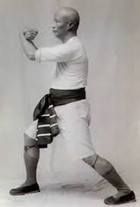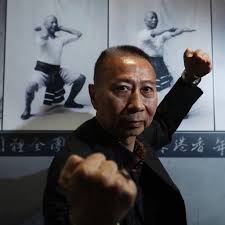Kung Fu Questions
- Chris Toepker

- Jun 7, 2020
- 10 min read

Always great to get cards and letters, and always happy to share info on martial arts history!
A fan of #CoffeeFu (brewed up fresh most Sundays on Twitter) wrote us with these questions:
1. America was fed the "kung fu" noun back in the 60s and 70s with the release of both good and bad action movies. Is there a term we should be using besides this Hollywood inspired word? Gong fu maybe?
TL;DR - Perhaps “martial epic” or “martial action” or similar. But “kung fu movie,” literally 功夫片 is exactly what audiences in Hong Kong, Taiwan and the Mainland call(ed) them. It was not inspired by or driven by Hollywood.
More - Using the word “fed,” suggests that there was a concerted effort at some intention. I don’t find this was the case. In common parlance across Hong Kong, Taiwan and the Mainland “功夫片” is entirely accepted and was not driven by Hollywood. “Kung fu” is a Romanization of 功夫, and so is “gong fu.” And 片 just means “movie.”
Having said that, there is a related genre, the 武俠片 or “Wu Xia Pian,” which means “martial hero epic.” The difference lies in the martial-action continuum. If a film is mostly action and fighting, it is a “kung movie” (again, across Greater China). Meanwhile, if there is more drama and characterization, it is a “martial hero epic.” Therefore something like “Kill Bill” is a kung fu movie, while “Crouching Tiger, Hidden Dragon” is a “martial hero epic."
2. In your travels, have you ever come across the mention of a tantric martial exercise known as the "lion's roar"?
TL;DR - yes...and no. Lion’s Roar is an age-old reference to Buddhist teachings and practice. They have morphed across the centuries and cultures where that has travelled. So, the question it would seem is “did someone, somewhere incorporate the words into their description of their practice?" I have to say: probably.
More - In general, it refers to the intensity of Buddha’s teachings. For example, the Illustrated Encyclopedia of Zen Buddhism notes “Lion’s Roar: An expression indicating intensity and power, since a lion’s roar is said to possess the resonance of one hundred animals. Buddhist scriptures often apply the original Sanskrit expression ‘simha nada’ to describe the unsurpassed quality of the Buddhua teaching the Dharma.”
More specifically, around the year 1,000 the phrase and whatever technique it might have been specifically associated with, was apparently widespread. For example, it appears numerous times in the Blue Cliff Record (I like the translation by Thomas Cleary). It is unclear at that time if it referred to simply The Teaching (as above) or to a specific shout. However, certain teachers were known for shouting suddenly at their students to startle them into enlightenment! For sure, both interpretations are possible from reading the text, and some anecdotes seem to point to one interpretation or the other...or both.
So, the question it would seem is “did someone, somewhere incorporate the words into their description of their practice?" I have to say: probably. As Tantric practices cross over to the sexual, one has to wonder what a “tantric martial practice” even is. Might I suggest that it’s a further confusion of age-old euphemisms for sex in China? Some of them have fighting, like one might say “having a tussle under the covers.” In any case, one would have to seriously wonder about the efficacy of a sexual martial art for combat purposes!
3. As an experienced Hung Gar practitioner, can you tell me if the hand techniques towards the middle of the Tiger/Crane set are Hung Gar, or hands from some other style?
TL;DR - Everything, everywhere is from some other style.
More - to fully answer this question would be to delve deeply into the history of martial arts...Chinese or any...and their era by era progress and mutual context. If someone wants to sponsor me to write that out - let me know!
In short, the of Chinese martial arts for the average person before the early modern era was: join the army as a soldier, get promoted to NCO through displays of prowess in tests and contests, retire, get asked by your family and neighbors to help them get advanced by teaching them a thing or two. This boils down to an environment where techniques were regularly exchanged and improved and applied, round and round and round. No really fixed styles, simply “training for the military.”
Indeed, Shaolin can be explained by this cycle. Shaolin was among the earliest of the “mahayana” schools in around the 500s and was OK accepting former soldiers. One can easily imagine that by the time the martial arts were authorized by the Tang dynasty, several generations of men had brought that same cycle within the walls.
By the mid-1850s, with modern armies trouncing traditional ones, China started to reform. Northern China overhauled their practices fairly quickly and fielded more modern military units, thus doing away with the old martial arts contests. Southern China was slower to do so. The upshot of this is that the particulars of the martial arts of the time got frozen and that was what was transmitted - especially in the South.
The particulars of the Hung techniques are a great example because they were recorded by someone who lived through this period: Lam, Sai Wing (林世榮). We have not only his anecdotes and instructions on the techniques, but also his famous photographs and books. Of course, his family also received the transmission...but, importantly, not all the context. After all, the world had (and has) changed! Nevertheless, the spirit remained the same...including the integration of other techniques. Specifically, Lam Cho (林祖) worked with many Hong Kong practitioners and incorporated many of their elements into Hung Kuen, while simultaneously keeping the essence. This, to me at least, is strong evidence of the cultural practices that stretch back to antiquity and put to rest the whole “it’s better because it’s traditional” nonsense. I mean, the “tradition” is to master then mix - just as MMA teaches today!
As for the specific crane movements, there is probably no exact telling of where those techniques migrated from. It is quite possible that they were spread across the south and exchanged in the waning days of the old-school Chinese army and simply got freeze-framed by Lam, Sai Wing’s book.
4. Why are the broad collection of martial styles today advertising the hand-to-hand mode when sword, spear, and cudgel are the true weapons of war? I mean, "martial" has to have something more to it than point sparring, headlocks, body slams.
TL;DR - Any school, whether in 1800s China or 2000s USA, has to teach what people will pay for. Since weapons aren’t what people will pay for these days...because wearing cold steel weapons is out of vogue...you get a focus on hand-to-hand. Again, a lengthy answer would require a volume and if someone wants to sponsor me to write that out - let me know!
More - It’s true that martial arts schools going back a very long time taught using military grade weapons. Indeed, one differentiator to "traditional" schools vs. "modern" schools is the weight and heft of their weapons. After all, originally the training was to help recruits and NCOs get promoted (as well as do well in actual battle, of course). By the 1850s though, as modern military techniques were adopted by the nation, the older ways first took up a police-style or security-style role before being replaced entirely. As for today, in our Lam Family Hung Kuen tournaments, your equipment has to meet late-Qing, early Republican era standards used by army and police. You won't see flimsy, whippy swords at our events, for example.
Taking a further look at the question, though: what is "a weapon of war"?. For one thing, a “cudgel” was not. When a nation sent an army out, it did so full of sharp and pointy bits. The police, on the other hand, use blunt instruments. One can see this in similarities of certain weapons, like the straight sword (jian) and the “whip.” (Below, whip on the left, ancient jian on the right.) One is simply the blunt version of the other, no? Likewise, the security...think Pinkertons or Blackwater...aspects. The army did not use three-section staves or butterfly swords. Those were much more popular with street-level operations.
At the same time, I’m curious about the “more” that you’re looking for. After all, the famous general Qi, Ji Guang (戚繼光) observed "the effective is not beautiful.” Certainly I’d have to agree there should be more than “point sparring” because if you’re expecting self-defense, that isn’t kept by points. Still, headlocks and body slams should certainly be a part of the equation!
5. Millions of Americans believe in the "kung fu fighting" version of the Shaolin temple. In your opinion, how did this myth of bald, snap-kicking Ch'an priests begin?
TL;DR - this isn’t a myth, but the commonly understood story has gotten far from the facts.
More - Shaolin was authorized by Li ShiMin , the Tang prince, to have fighting monks. Essentially a small standing brigade of 800. He authorized this after he was rescued by a small squad of highly skilled martial arts from the temple. Put simply, in about the 500s, Shaolin was among the first (if not the first) “Mahayana” (and Zen/Chan/禪) school of Buddhism. As such, it was OK in accepting former military men. As these men retired, they certainly brought that know-how with them. It would seem that, with the favor from the capital just over the hill at Luoyang and the riches it accumulated, the temple was often the target of thieves. One can easily imagine how those ex-soldiers made use of their training to further their Zen studies and protect themselves and their faith. Think of them as the Templars of Asia, in this sense.
The temple’s martial history and prowess continued, waxing and waning to be sure, up until around the 1850s when it started fading and ultimately, after the 1949 revolution, winked out of existence. The “tradition” that is there is manufactured. It has no actual links to previous teaching.
Does this mean everyone at the temple was trained or in training? No. One can look to similar trends in Japan and easily imagine how the philosophic and martial trends intertwined.
This is the barest of thumbnails - if anyone wants to sponsor the full story, I’d happily spend the time finishing the translations and research I have!
6. Shaolin is a large tourist destination. What arts are they demonstrating today? Are the "priests" truly Chan priests, or paid actors like in the Old Frontier recreation stops as seen in National Lampoon's "Vacation"?
TL;DR - It’s a matter of degree. In my book, they’re mostly like the recreation stop because both the religious and martial practices are bound by strict CCP limits.
More - The current version of the temple’s practices are only a few decades old. The CCP banked on the cultural cache both at home and abroad and starting in the 1980s, using film and stage, they broadcast a sanitized (one might even say “Disney-fied”) version of Chan, martial arts and so on.
7. I notice the presence of "gum gong" sets. These were valued as the more advanced sets. When searching for examples on YouTube, I am hit with a collection of kung fu sets, kempo sets, and etc. So is the "gum gong" monkier the gold standard, or just in some kung fu traditions?
TL;DR - “gum”or “jin” or 金 is a euphemism for “qi” (氣) and the meridians that reportedly carry it. It's likely just another way of saying "internal" set. For more about "gold standard," see below.
8. I know "gum gong" is supposed to mean "gold." Surely there's more to this word than "advanced" and "gold." How about the related word Jin Gang. I know it's a "ritual" device in Tibetan Buddhism (Vajra), but it's used in Bashi kung fu as well. What is up with this word? I also understand it's now a hotel.
TL;DR - “Gold” is often mistranslated. While it certainly can refer to gold, it is also simply “metal.” For example, the five elements is also “gold” (金), but how many translate it as such in that context? Even better, a hardware store is a “five metal/gold store” (五金行). It does not imply value or advancement in any way. That is a cross-cultural affiliation and assumption.
The related Jin Gang (金剛) is a funny one. In common usage, it's King Kong. Yes, the giant ape! More figuratively it refers to something "strong and hard" and implies invulnerability, like those magical Boxer techniques. Similarly, it likely has some cultural crossover effects since (as noted!) "jin gang" also refers to aspects of Buddhism, specifically "vajra." This likewise has several inferences including a mace and thunderbolt. So, is it any wonder someone thought it'd be a cool name for a hotel? Or maybe they wanted to imply that ape after all?
9. In my practice, kung fu led me to become a student of Dzogchen. Do you find in your travels (sometimes) this spiritual shift from kung fu to some expression of transcendental study?
TL;DR - Yes, from time to time folks transfer interest from curiosity to martial arts to a religion.
10. Would you say that the Boxer Rebellion's propaganda (you can block bullets with your torso, go!!!!) has had a hand in driving kung fu to be known as a hand-to-hand art in some ironic fashion?
TL;DR - No, I don't think so. The idea is nonsense. As people at the time noted: if it really worked, we wouldn’t have lost. It might have looked cool in the movies, and in some small way enabled power fantasies, but I don't think anyone got past Class One in a curriculum with that illusion!
More - This excellent book: Origins of the Boxer Uprising.
11. I understand that guns were used in Chinese street gangs from the dawn of the 20th century. Why did the gun and other implements of war override the hand-to-hand aspect in kung fu when it was "taken to the streets."
TL;DR - for the same reason firearms took over fighting everywhere: they’re easy to use, requiring little training, and do great damage.
More- Below are some snapshots I took in a fave location in Beijing: the southeast guard tower. It's where the occupying Eight Nation Army took up positions when defeating the Boxers in 1900. Their graffiti is carved into the wall, plain as day even now. The site is a city defense museum and features some weapons of the period, including "street level" shotguns, meant to be attached to the tops of spears or poles. This tech was wide spread, and can be seen in art back to at least the 900s, as seen in cave works in Dunhaung.
As I’ve mentioned, I’d be happy to get more details onto paper, tracing the history of this...especially with the Chinese experience...and would welcome sponsorship - let me know, people!
12. In your travels today, have you ever noticed or heard about Chinese gangs using kung fu schools as a means of laundering cash?
TL;DR - I have not personally seen this with my own eyes nor heard of it in any schools I know. However, it makes total sense given how money laundering works!





























Comments